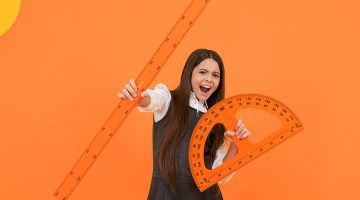What is a Multiple in Math? All Kids Need To Know
Updated on April 22, 2024
As a math teacher, you may be called upon to teach kids how to work with multiples in math. But this task would be impossible if you don’t understand the rudiments of the topic. That is because you would need to first teach the students what a multiple is before highlighting the kinds of questions they can expect from it in their tests and exams.
To answer the question of what is multiple, you must understand that a multiple in math is any number you can multiply a positive whole number with any other random number. You can call this “random number” a factor for the tutorial’s sake. Or if you are teaching younger students, just say numbers like 1,2 and so forth.
These factors should divide the whole number without resulting in a fraction. When teaching, you can use the integer 10 as an example. All the whole numbers that you can multiply to get 10 (which are 2 and 5) are its factors. This is one of the easiest examples you can use when answering the question of what is a multiple in math.
Finding Multiples
You can’t determine a multiple without knowing the numbers that are its products. To do this, pick its lowest factor and multiply it by other numbers in an increasing sequence. There are several ways to go about this, and they include the multiplication method, skip counting, and listing.
For the multiplication method, you can just multiply the base (factor) with a handful of positive integers. It is a great way to get them to do some multiplication facts practice.
On the other hand, skip counting lets you add a positive integer to itself over and over until you get to the required multiple. Finally, the listing method requires that you or the students pick a whole number, then make a list of several factors of that number and multiply them by consecutive quantities that lie on the positive axis on the number line.
Depending on how you approach these strategies, you can make the exercise of learning what are multiples something your students look forward to. If you need somewhere to start, consider these examples:
Multiplication Method
Question 1:
Using only the multiplication method, what factors can give you the multiple 12?
Solution:
4 x 3 = 12 (where 12 is the multiple and 4 and 3 are the factors)
2 x 6 = 12
Question 2:
Using only the multiplication method, what factors can give you the multiple 24?
Solution:
6 x 4 = 24
8 x 3 = 24
12 x 2 = 24
Note that there are no decimals or fractions in any of these numbers. Next, let’s try finding the factors of 12 using the skip-counting method.
Skip-counting Method
Question:
Using only the skip-counting method, what factors can give you the multiple 12?
Solution:
You should subtract 12 from every number before it to find its factors that can be multiplied to give you 12 without becoming fractions. Therefore, the answers are 6, 4, and 3.
Listing Method
Question:
Using only the listing method, what factors can give you the multiple 24?
Solution:
For this method, you can find the factors of 24 by making a list of pairs of numbers that you can multiply to give 24 without any remainders. That list should look like 1, 2, 3, 6, 8, 12, and 24.
1 x 24 = 24
2 x 12 = 24
4 x 6 = 24
3 x 8 = 24
If you want to spin these questions around and make 12 and 24 the factors, you can! Simply ask the students to find the multiples of 12 and 24 using the methods above. For example:
Question:
What are the multiples of 12 using the listing method?
Solution:
12 x 1 = 12
12 x 2 = 24
12 x 3 = 36
12 x 4 = 48
12 x 5 = 60
Common Multiples — Definition and Examples
In multiple math, common multiples are two or more numbers that can be evenly divided by two or more numbers (that appear for both multiples) with no remainder.
Let’s illustrate this with the factors 15 and 30:
- The multiples of 15 are 15, 30, 45, 60, 75, 90, etc.
- The multiples of 30 are 30, 60, 90, 120, 150, 180, etc.
From these lists, you can ascertain that the common multiples of 15 and 30 are 30, 60, 90, etc., because they appear in both lists. These numbers can be divided evenly by 15 and 30.
Interactive Activity
Teaching what is a multiple to kids may require more interaction because the numbers can get confusing.
So, what is the best approach to this conundrum? Making it playful or gamifying the lesson!
You can borrow this example from us:
Hey, students! Imagine you’re on a treasure hunt adventure in a magical land. Your mission is to find the hidden treasure, which you can only unlock by discovering the common multiples of two enchanted numbers: 15 and 30.
How do you succeed in this quest? First, draw a map on your paper and divide it into three sections, one for each enchanted number. Label them as Number 15 and Number 30. Afterward, draw a small treasure chest at the end of each section.
Write down the first few multiples of each enchanted number in their respective sections. Use colorful markers to make it exciting!
Let it look like this:
Number 15: 15, 30, 45, 60, …
Number 30: 30, 60, 90, 120, …
Your task is to find the “Common Multiples Treasure” where the magical numbers overlap. Circle or mark the common multiples you’ve found on your map. Then add the common multiples you found to unlock the treasures within the chest!
Math Games
Teaching kids the definition of multiplication and asking them to find a multiple of 3 will be much more fun if you include fun activities like the above interactive activity. Alternatively, use math riddles, games or puzzles like the ones below.
Multiples Hopscotch
Draw a hopscotch grid with numbers and their multiples. Players hop through the grid while calling out the multiples they land on.
Multiples Tic-Tac-Toe
You can create a tic-tac-toe grid and fill it with multiples of different numbers. Players must solve a math problem based on multiples before placing their X or O on the grid.
Multiples Race
Draw a number line with multiples of a specific number. Players roll a die and move that number of spaces, identifying the multiple they land on.
Multiples Target Practice
Set up a target with different point values for multiples of a certain number. Players throw objects (like bean bags) at the target and score points based on the multiple they hit.
Multiples Relay Race
Here, you need to divide players into teams. Place multiples of a number at various points along a path. Players take turns racing to the multiples and back to their team, accumulating points.
Puzzles and Riddles
Here are some puzzles and riddles to help kids understand multiples better:
Missing Multiple Puzzle
Fill in the missing multiples in a sequence. For example, if the sequence is 5, __, 15, 20, __, 30, the missing multiples are 10 and 25.
Multiples Crossword Puzzle
Create a crossword puzzle with clues that involve multiples. For instance, the clue could be “A multiple of 7 that comes after 21” (The answer is 28).
Multiples Sudoku
Create a Sudoku grid where the numbers in each row, column, and box are multiples of a specific base number.
Multiples Cryptogram
Encode a message using multiples. Assign each letter a number value (e.g., A=1, B=2, …, Z=26) and create a message using the multiples of a chosen base number.
Multiples Maze
Design a maze where the path is determined by moving along multiples of a certain number. Players must follow the multiples to reach the exit.
Real-life Applications of Multiples
We use multiples every single day in our activities. You may not be aware of it, but some of your day-to-day businesses require a basic understanding of multiples, and teaching kids this gives them a chance to learn the math concept better.
Some everyday real-life applications of multiples are:
Grocery Shopping
When buying items at the grocery store, you might buy multiples of products, such as 4 cans of soup or 2 liters of milk.
Baking and Cooking
Recipes often involve using multiples of ingredients, like measuring 2 cups of flour or 3 teaspoons of sugar.
Counting Money
When counting money, you’re dealing with multiples of coins and bills, such as counting out 5 dollars (a multiple of $1 bills) or 25 cents (a multiple of 5-cent coins).
Telling Time
The concept of multiples is inherent in telling time. For example, each hour has 60 minutes (a multiple of 60), and each minute has 60 seconds.
Calendars
A calendar is organized around multiples of days, weeks, and months. A week consists of 7 days, and a month consists of multiple weeks.
Recurring Events
Consider regular events, like a weekly garbage collection or a monthly bill payment. These events occur in multiples of days or weeks.
Conclusion
Multiples are helpful in everyday life, so passing the concept down to our kids and students is very important. We need to prepare our kids for a math-based world by using all the resources to keep them on their toes. But our schedule or level of understanding of the topic may be a limiting factor, so it’s a great idea to hand the task over to the experts!
Brighterly is an excellent platform that teaches kids to solve math problems on the ‘multiples’ topic using games and videos to increase their concentration and understanding. If you want your kids to improve their math skills, register them now.












